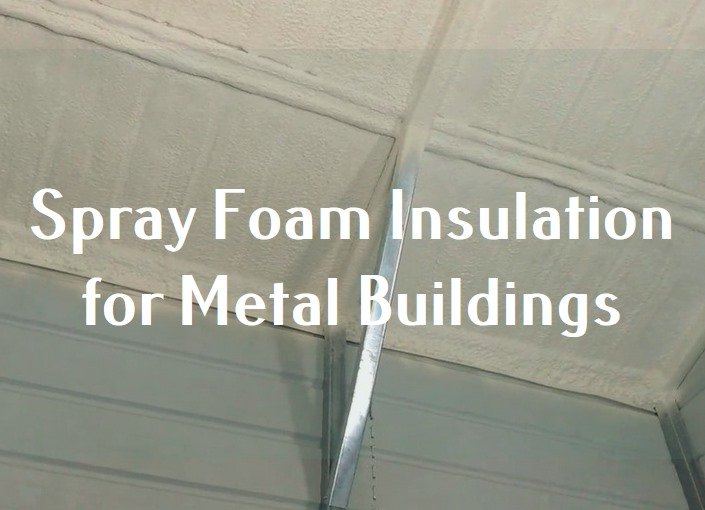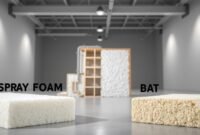Metal building owners struggle to keep their spaces warm and energy-efficient. Drafty buildings waste money and make places uncomfortable. Old insulation methods don’t work well, leading to energy loss and temperature swings.
Spray foam insulation is a game-changer for metal buildings. It creates a tight seal, changing how we insulate. I’ll show you how to use the latest methods to insulate your metal building.
By the end of this guide, you’ll see why spray foam insulation is key. It boosts metal building performance, comfort, and saves on energy.

Understanding Spray Foam Insulation Basics
Spray foam insulation has changed how we keep metal buildings warm and dry. As a construction expert, I’ve seen how it boosts building performance.
Types of Spray Foam: Open-Cell vs Closed-Cell
In metal buildings, there are two main types of spray foam:
- Open-Cell Foam: Soft and flexible, with a spongy feel
- Closed-Cell Foam: Dense and firm, great for keeping moisture out
Closed-cell foam is the top pick for metal structures. Its tight cells block gaps and cracks well, giving top-notch protection.
How Spray Foam Works in Metal Structures
Spray foam insulation changes how metal buildings handle heat and energy. It fills tiny gaps and cracks, making a tight seal. This is better than old insulation methods.
Chemical Composition and Properties
The secret of spray foam is its special mix. It’s usually polyurethane, with two parts that mix and expand when sprayed. This makes a perfect insulation layer on metal buildings, keeping them warm.
| Property | Open-Cell Foam | Closed-Cell Foam |
|---|---|---|
| Density | 0.5-1.0 lbs/ft³ | 1.5-2.0 lbs/ft³ |
| R-Value per inch | 3.6-3.8 | 6.0-7.0 |
| Moisture Resistance | Low | High |
Benefits of Spray Foam Insulation for Metal Buildings
Spray on foam insulation is a game-changer for metal buildings. It offers many benefits that traditional insulation can’t match. I’ve seen how it transforms metal structures, making them better protected and more efficient.
The main advantages of spray foam insulation for metal buildings are:
- Superior thermal performance
- Exceptional moisture barrier protection
- Enhanced structural integrity
- Significant energy efficiency improvements
- Noise reduction capabilities
Closed-cell spray foam is a standout for metal buildings. It creates a tight seal, stopping water and preventing damage. It fills gaps and cracks, giving a better protection than other insulations.
Another big plus is energy savings. Spray foam insulation cuts down on air leaks and keeps temperatures steady. This means lower bills for heating and cooling, making it a smart choice for owners.
It also makes metal buildings stronger. The foam adds to the building’s stability, which is great for areas with harsh weather or strong winds.
In short, choosing spray foam insulation is a wise move. It boosts your building’s performance, saves energy, and protects it for years to come.
Read also: The Problems With Spray Foam Insulation in Attics
The Complete Guide to Installing Spray Foam Insulation in Metal Buildings
Installing spray foam insulation in a metal building needs careful planning and precise steps. I’ll guide you through the key steps for a successful application. This will help make your building more energy-efficient and protected.
Surface Preparation Requirements
Before applying spray foam insulation, it’s important to prepare the surface well. Here’s what to do:
- Remove all debris and loose materials from the surface
- Clean the metal thoroughly using a power washer or wire brush
- Inspect for rust or damage and repair any compromised areas
- Ensure the surface is completely dry before application
- Check temperature and humidity levels for optimal spray foam installation
Application Techniques and Best Practices
When using a spray foam insulation kit for metal buildings, follow these professional techniques:
- Start spraying from the top of the wall and work downward
- Maintain a consistent distance of 12-18 inches from the surface
- Apply in thin, even layers to prevent excessive expansion
- Allow each layer to cure completely before adding additional layers
- Use overlapping spray patterns for complete coverage
Safety Measures During Installation
Safety is key when learning how to spray foam a metal building. Always wear protective gear:
- Full-body protective suit
- Respiratory mask with organic vapor cartridges
- Safety goggles
- Chemical-resistant gloves
- Ensure proper ventilation in the work area
By following these guidelines, you’ll get a professional-grade spray foam insulation installation. This will improve your metal building’s performance and last longer.
Cost Analysis: Spray Foam Insulation for Metal Buildings

Knowing the cost of spray foam insulation for metal buildings is key for any project. The price can change a lot based on several important factors.
When figuring out the total cost, consider these key points:
- Building size and total square footage
- Type of spray foam (open-cell or closed-cell)
- Thickness of insulation layer
- Regional labor rates
- Complexity of installation
The cost of spray foam insulation for metal buildings is usually between $1.25 and $4.50 per square foot. Closed-cell foam is pricier but gives better insulation and keeps moisture out.
Here’s a look at the possible costs:
- Small metal building (under 1,000 sq ft): $1,250 – $4,500
- Medium metal building (1,000-5,000 sq ft): $5,000 – $22,500
- Large metal building (5,000-10,000 sq ft): $22,500 – $45,000
Even though the initial cost might seem steep, spray foam insulation saves money in the long run. Most owners see their investment pay off in 3-5 years through lower energy bills.
Pro tip: Always ask for quotes from certified pros to find the best deal for your metal building insulation needs.
Energy Efficiency and Temperature Regulation Benefits
Spray foam insulation makes metal buildings very efficient. It’s key to know how much you need for great energy savings.
Metal buildings have special temperature needs. Spray foam stops heat from getting in, keeping the inside cool or warm, no matter the outside weather.
R-Value Performance Breakdown
The R-value shows how well insulation works. Spray foam beats other materials in keeping things cool:
- Closed-cell spray foam: R-6 to R-7 per inch
- Open-cell spray foam: R-3.5 to R-4 per inch
- Fiberglass batts: R-2.2 to R-2.7 per inch
Long-Term Energy Savings Strategy
Think about the savings when choosing spray foam. Most metal buildings need 2-3 inches of closed-cell spray foam. This can cut heating and cooling costs by 40%.
Climate Control Advantages
Spray foam seals well, stopping air leaks. This makes the inside temperature steady. So, summers are cooler, winters warmer, and energy use goes down for metal building owners.
Choosing the right spray foam thickness boosts your building’s thermal performance. It also saves energy in the long run.
Moisture Control and Condensation Prevention
Metal buildings always fight against moisture. Spray foam insulation is a strong defense. As a building protection expert, I know how important it is to control moisture.
Spray foam insulation makes a great moisture barrier. It stops condensation in metal buildings. It seals all cracks and crevices, keeping water vapor out.
- Blocks moisture infiltration completely
- Prevents mold growth
- Reduces rust and structural damage
- Improves building durability
Spray foam insulation is a game-changer for metal buildings. Its airtight seal protects against moisture. It keeps spaces dry and safe from moisture damage.
Using spray foam as a moisture barrier has many benefits:
- Eliminates condensation risks
- Protects metal from corrosion
- Keeps indoor air quality good
- Extends the building’s lifespan
Investing in quality spray foam insulation does more than control moisture. It protects your metal building from long-term damage.
Structural Benefits and Building Integrity
Spray foam insulation for metal buildings does more than just control temperature. It offers amazing benefits that boost the metal structure’s overall strength.
Can spray foam insulation make a metal building stronger? Yes, it can! Spray foam’s special properties make metal buildings stronger against different environmental challenges.
Impact on Metal Building Longevity
Spray foam insulation protects metal buildings, making them last longer. It acts as a barrier that stops:
- Moisture from getting in
- Corrosion from forming
- Structural damage
- Metal panels from separating
Load-Bearing Enhancement
Closed-cell spray foam is very strong, making buildings stronger too. It helps spread weight evenly and lowers stress points.
| Spray Foam Type | Compressive Strength | Structural Impact |
|---|---|---|
| Closed-Cell Foam | 25-40 PSI | High Structural Support |
| Open-Cell Foam | 4-10 PSI | Limited Structural Support |
Weather Resistance Properties
Spray foam insulation adds a layer of protection against harsh weather. It shields buildings from strong winds and storm damage.
Choosing spray foam insulation for metal buildings is a smart move. It boosts energy efficiency and strengthens the building’s structure for the long term.
Read also: 5 Common Spray Foam Insulation Roof Problems
DIY vs Professional Installation Considerations
Choosing between DIY and professional installation for spray foam insulation in metal buildings is tough. Some homeowners want to try spray foam kits themselves. But, the process is not always easy.
Here are the main points to think about if you’re wondering who does spray foam insulation in your area:
- DIY Pros:
- Lower upfront costs
- Flexibility in scheduling
- Personal satisfaction of completing the project
- DIY Cons:
- Potential for improper application
- Risk of incomplete coverage
- Lack of professional equipment
Professional installation has big benefits. Experts know how to insulate metal buildings right. They use special tools and know-how for full coverage and best results.
For most metal building projects, I suggest getting a pro. The right spray foam application is complex. DIY might not save money in the long run. Pros ensure:
- Precise application techniques
- Comprehensive building envelope sealing
- Warranty protection
Before deciding, get quotes from local spray foam insulation pros. They can give you a detailed plan for your metal building’s needs.
Common Challenges and Solutions in Metal Building Insulation
Learning to insulate a metal building comes with its own set of challenges. Metal structures often have gaps and cracks. These are hard for traditional insulation to cover well.
The main problems you’ll face include:
- Thermal bridging through metal frames
- Persistent moisture infiltration
- Difficult-to-seal gaps and cracks
- Uneven surface temperatures
Spray foam insulation is a top choice for these issues. It fills gaps and cracks well, making a solid thermal barrier. Experts can reach hard spots, covering the metal building fully.
To tackle gaps and cracks, start with a detailed check of your metal building. Look for spots where air and moisture might get in. Use spray foam or special sealants to seal these areas tightly.
Experts suggest a step-by-step plan for insulating a metal building:
- Do a full building check
- Clean and get surfaces ready
- Pick the right insulation materials
- Use professional methods to apply insulation
- Do a leak test after installation
Knowing these challenges and using the right solutions can greatly boost your metal building’s energy use and strength.
Maintenance and Long-Term Performance
Keeping your spray foam insulation in top shape is important. It’s a smart choice for metal buildings because it lasts for decades. This makes it a great investment for property owners.

Spray foam insulation is more durable than other types. It keeps your building warm and strong for years. Its special mix ensures it works well over time.
Key Durability Factors
- Resistance to moisture and water damage
- Minimal settling or compression
- Chemical stability under extreme temperatures
- Protection against pest infiltration
Inspection Guidelines
Regular checks are vital for your insulation. I suggest inspecting it every two years. This keeps it working at its best.
- Check for visible cracks or gaps
- Inspect for signs of moisture intrusion
- Verify consistent thermal performance
- Look for any signs of pest damage
Repair Procedures
For any damage, get a pro’s opinion. Small problems can be fixed by adding more foam. This keeps your insulation strong.
Spray foam insulation is a long-term asset for metal buildings. With the right care, it will serve you well for years. Follow these tips to get the most out of your insulation.
Environmental Impact and Sustainability Features
When looking at spray foam insulation for metal buildings, it’s key to know its environmental impact. These solutions bring big ecological benefits over old insulation methods.
Today’s spray foam insulation has made big steps in being green. New formulas cut down on carbon emissions and boost energy efficiency in metal buildings.
- Reduced energy consumption through superior thermal performance
- Lower greenhouse gas emissions during manufacturing
- Extended building lifecycle with enhanced durability
- Minimized material waste during installation
Eco-friendly spray foam insulation for metal buildings cuts a building’s carbon footprint a lot. The new chemicals use recycled materials and low-global warming agents.
| Environmental Metric | Spray Foam Performance | Traditional Insulation |
|---|---|---|
| Energy Efficiency | 90% improvement | 60% improvement |
| Carbon Reduction | 35% lower emissions | 20% lower emissions |
| Lifecycle Sustainability | 25-30 years | 15-20 years |
Choosing spray foam insulation for metal buildings does more than protect your investment. It also helps the planet. The benefits go beyond just saving energy.
Conclusion
Exploring spray foam insulation for metal buildings shows a powerful solution. It changes how we build, making buildings more efficient and safe.
This guide has shown the great benefits of spray foam insulation for metal buildings. It improves energy use and controls moisture well. It also makes buildings stronger and last longer.
Choosing the right insulation is important. Spray foam is great, but knowing how to install it and its costs is key. Always talk to insulation experts for your metal building project.
Spray foam insulation is a smart choice for metal buildings. It makes them last longer, use less energy, and stay strong. Using this technology helps make buildings better for the environment and more comfortable for everyone.


